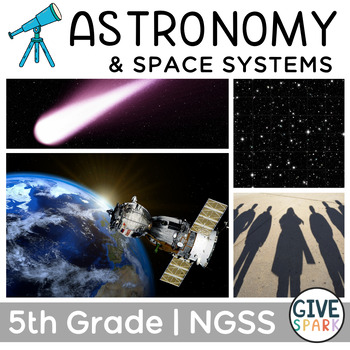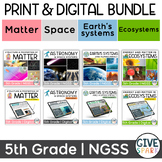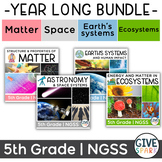5th Grade Science: Astronomy & Space Systems - NGSS Aligned - Printable Unit
- Zip
What educators are saying
Also included in
- 5th Grade - Astronomy: Space Systems - PRINT AND DIGITAL bundle - NGSS Super BundleThis comprehensive teaching unit is specifically designed for fifth-grade students to learn about the topic of astronomy aligned with the NGSS standards.Standards Alignment:The unit consists of 10 engaging lessons fulPrice $22.50Original Price $29.95Save $7.45
- Fifth Grade NGSS: The Ultimate Teaching Bundle – Print & Digital!Get ready for an exciting teaching journey with this all-in-one bundle, perfect for fifth-grade teachers. This package features four highly engaging science units, meticulously aligned with the Next Generation Science Standards (NGPrice $90.00Original Price $119.80Save $29.80
- 5th Grade Science Super Bundle: A Comprehensive Set of NGSS Aligned Teaching UnitsWelcome to the ultimate science teaching solution for 5th grade educators - the 5th Grade Science Super Bundle. This all-inclusive package is specially designed to ignite curiosity, enhance understanding, and fuel thePrice $57.00Original Price $67.80Save $10.80
Description
5th Grade - NGSS Aligned - Complete Unit: Astronomy: Space Systems
This comprehensive teaching unit is specifically designed for fifth-grade students to explore the fascinating topic of Astronomy and Space Systems. The unit consists of 10 engaging lessons that incorporate hands-on activities, interactive discussions, and exciting investigations. It is fully aligned with the Next Generation Science Standards (NGSS) for fifth grade, focusing on standards related to Astronomy and Space Systems, including 5-ESS1-1, 5-ESS1-2, and 5-PS2-1
APPROACH TO LEARNING
Unlock your students' natural curiosity and passion for science with this interactive and hands-on teaching unit. Designed to connect with their prior knowledge and provide immersive experiences, this unit offers 11 engaging lessons that guide students through complex scientific principles in an accessible way. Students will actively participate in hands-on experiments and activities that make learning exciting and memorable. This unit promotes independent learning and encourages students to reflect on their understanding, helping them build a solid foundation of knowledge in a fun and stimulating environment.
WHAT'S COVERED?
In this unit, we look at the following topics:
- Lesson 1 - How do people know what is in space?
- Lesson 2 - How far away is space?
- Lesson 3 - What is a solar system?
- Lesson 4 - How does Earth move in space?
- Lesson 5 - What causes the seasons?
- Lesson 6 - What is the moon and what do we know about it?
- Lesson 7 - What are stars?
- Lesson 8 - Why do some stars appear brighter than others?
- Lesson 9 - Why do stars move in the night sky?
- Lesson 10 - Why is gravity different on different planets?
End-of-Unit Project: Celestial Cinema
Celestial Cinema offers students a unique opportunity to explore the wonders of space through their own creative lens. As directors, writers, and producers, they will develop their own TV shows centered around space-related topics they have learned in this unit. Throughout the project, students will research, brainstorm, script, and bring their ideas to life using various media formats like animations, live performances, or stop-motion animations. They will engage in the engineering and design cycle, apply scientific knowledge, and foster critical thinking and communication skills. Celestial Cinema provides an immersive learning experience that combines science, technology, creativity, and teamwork.
✏️ What's Included?
Included in this comprehensive teaching unit are:
- Total of 10 core lessons: This unit comprises of 10 core lessons that cover all of the content of Space Systems for fifth-grade students aligned with the NGSS standards.
- Teaching Presentations: You will receive 10 teaching presentations in both PowerPoint (PPT), Google Slides, and PDF formats. These presentations are highly engaging and interactive, to create a fun and memorable learning experience.
- Teacher Guide: A complete Teacher's Guide is provided, offering scripted lesson plans, an overview of the unit, alignment with standards, and a list of materials needed for each lesson. All links and resources are also embedded within the guide.
- Student Science Journal: Students use an engaging science journal designed specifically for this unit. The journal includes various activities such as reading exercises, Time to Think challenges, experiments, vocabulary tasks, reflections, and more. This is a wonderful keepsake to record all of the students' learning.
- End-of-Unit Project: The unit culminates with an exciting project called Celestial Cinemas where students will collaborate to create space-themed TV shows based on their learning. A separate teaching guide, presentation, and project book are provided to guide the problem-solving process.
- Reading Tasks: A range of read and respond activities are included to enhance reading comprehension skills and to check student understanding throughout the lessons.
- Time to Think: Group discussion activities are provided to foster critical thinking and collaborative learning among students.
- Hands-On, Engaging Labs/Activities: Throughout the unit, there are 12 hands-on and engaging labs/activities designed to build students' knowledge and understanding of Space Systems.
- Formative/Summative Assessments: To gauge students' progress, a variety of comprehension tasks, quizzes, and reflection/journal prompts are included.
- Vocabulary Posters: Key vocabulary terms are reinforced with visually appealing posters.
- Answer Key/Model Answers: Save time on marking! An answer key or model answers are provided for your convenience.
With this comprehensive package, you have all the necessary resources to deliver engaging and effective lessons on Space Systems to your fifth-grade students.
⭐⭐⭐Please download the preview to see all that is included, including samples of everything!⭐⭐⭐
NEED HELP?
Before leaving feedback:
- Email me at givesparkco@gmail.com
- submit a help ticket
- ask a question on the Q& A tab
⭐⭐⭐⭐⭐ Please Leave a Review ⭐⭐⭐⭐⭐
Thanks for stopping by x
Vicky








